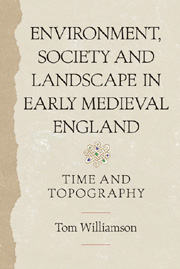Book contents
- Frontmatter
- Contents
- List of Illustrations
- Acknowledgements
- Introduction
- 1 Settlement and Society
- 2 Nature's Frame
- 3 Culture, Ethnicity and Topography
- 4 Small Shires, Deep Roots
- 5 The Gradient of Freedom
- 6 Two Countrysides?
- 7 Village, Farm and Field
- 8 Landscape and Settlement
- 9 Woodland and Pasture
- Conclusion: Time and Topography
- Bibliography
- Index
- ANGLO-SAXON STUDIES
9 - Woodland and Pasture
Published online by Cambridge University Press: 05 April 2013
- Frontmatter
- Contents
- List of Illustrations
- Acknowledgements
- Introduction
- 1 Settlement and Society
- 2 Nature's Frame
- 3 Culture, Ethnicity and Topography
- 4 Small Shires, Deep Roots
- 5 The Gradient of Freedom
- 6 Two Countrysides?
- 7 Village, Farm and Field
- 8 Landscape and Settlement
- 9 Woodland and Pasture
- Conclusion: Time and Topography
- Bibliography
- Index
- ANGLO-SAXON STUDIES
Summary
Introduction
Some readers may be sceptical about the arguments set out over the previous chapters not so much because of the evidence there presented relating to fields and farms, but rather because of the character of certain other aspects of England's medieval landscapes. In particular, we are accustomed to hearing how ‘woodland’ areas must have been colonised later than champion ones, and must always have lagged behind them in terms of agrarian development, because they were characterised by extensive tracts of common grazing and woodland. Indeed, these are still sometimes treated by historians as little more than environments awaiting transformation into cultivated land, in spite of the light that has been thrown in recent decades on such matters as the sophisticated nature of medieval woodland management. As we have seen, there is little evidence that champion landscapes were actually characterised by a paucity of common grazing. On the contrary: in many heathland and downland areas the commons were particularly extensive. But the association of ‘woodland’ landscapes, and a relative abundance of woods, is more clearly established. The notion that this reflects the fact that the process of colonisation was slow and never fully completed in such districts is an old one, going back to some of the earliest writers on landscape history, but it has been given particular prominence in recent decades by writers like Brian Roberts and Stuart Wrathmell, and by Oliver Rackham, who have emphasised the broad correlation between ‘woodland’ regions and areas which were both well-wooded at the time of Domesday and which can boast a high proportion of place-names containing elements relating to woodland or its clearance.
- Type
- Chapter
- Information
- Environment, Society and Landscape in Early Medieval EnglandTime and Topography, pp. 207 - 233Publisher: Boydell & BrewerPrint publication year: 2012



